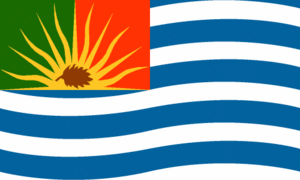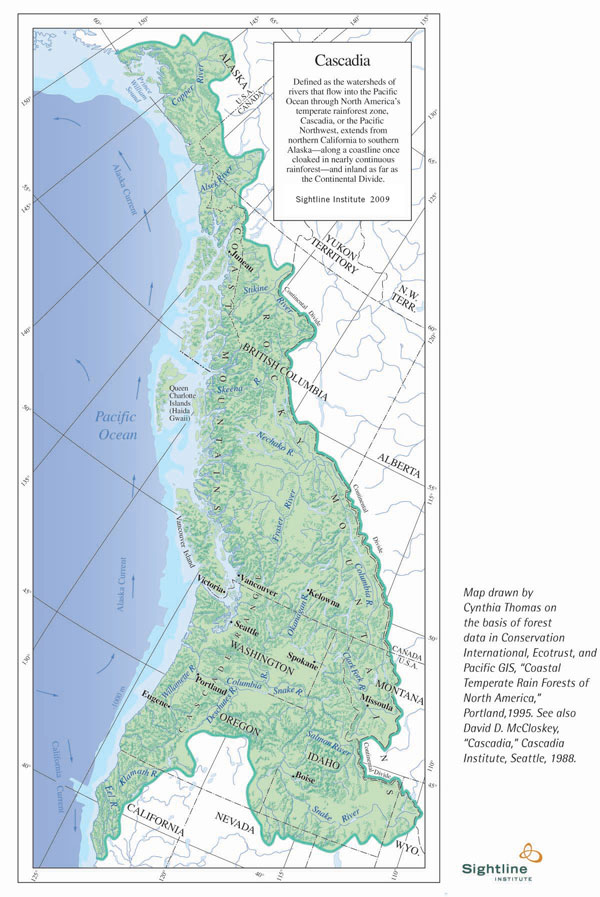Cascadia


Cascadia is a proposed independent nation in the Pacific Northwest, usually composed of Oregon, Washington, and British Columbia, that would be formed by seceding from the United States (and Canada).
Water and Forests
According to Sightline Institute "Cascadia is defined by water and forests: it encompasses all of the watersheds whose rivers flow through the temperate rainforests on the northwest Pacific coast."[1]
Statistics of the Republic of Cascadia[2]:
- Name: The Republic of Cascadia (long form), Cascadia (short form)
- Capital: Cascadia
- Area: 855,762 sq km
- Population: 14,220,981 (2005 est)
- GDP: US$323 billion (1996 est)
- Language: Cascadese (a dialect of English)
- Time System: Metric Time
Cascadia Subduction Zone
The Cascadia Subduction Zone Quake will generate two Tsunami waves, one propagating towards the coast, and the other towards the deep ocean and Hawaii.
It will take only minutes to reach the coasts of Oregon, Washington, southern British Columbia, and northern California with wave heights reaching close to 12m (~36ft) in some scenarios.
James Roddey, a geologist known as Oregon’s “Prophet of Doom,” explains it it stark terms. The coming Cascadia event could tip the scales at a magnitude above 9.5 – larger than all 20th-century earthquakes combined, according to Roddey, and last up to five minutes (Video).
Here's the scientific consensus on what will happen in Portland:
"Several of the 10 bridges across the Willamette River will collapse—the Steel Bridge, Sellwood Bridge and Marquam Bridge, most likely—and the rest will be impassible. Big Pink and other office towers will sway so violently their granite and glass façades will shear off and crash into the street, piling rubble up 4 feet deep. The Multnomah County Courthouse will tumble. Underground gas, power and water lines will be pulverized. The soil beneath the Portland International Airport will temporarily turn to soup."
The Red Cross has Earth Quake Kits and Humaninet has some tips that could save lives.
Gizmodo lists emergency apps such as Pocket First Aid and CPR, First Responder Info, Disaster Readyness, and Emergency Radio.
The 2011 Sendai earthquake and tsunami, with a magnitude of 8.9, made it the largest earthquake to hit Japan in recorded history and the sixth largest in the world since records began and may be a sister of the Earthquake and Tsunami that is likely to hit the Northwest in our lifetimes.
More information on the 2011 Sendai earthquake is available at Google News, Yahoo, Blog Runner, and TechMeme.
Ustream is carrying live TV feeds from the Japan public broadcaster, NHK, while Al Jazeera, The BBC, CNN and NPR have live blogs.
C/Net has links for finding family and friends. Here's a diagram and an OpenStreetMap of Japan.
Japan's Kobe Port was the country's busiest port until the Kobe Earthquake. Kobe has since dropped to the fourth in Japan and forty-fifth busiest container port worldwide (as of 2008).
OpenStreetMap has good map data of affected regions in Japan, and the Humanitarian OSM Team is on hand to help. CrisisWiki is an editable directory of resources related to disasters and crises around the world.
Oregonian stories and twitter feeds include ORTsunam, ARRL Emergency.
Social media and the web have become the go-to for real-time information, says Mashable. Facebook sites that cover the quake include JapanEarthquake, Solidaritytsunamimarch2011, and the The US Weather Service.
The Quake produced a flood of Tweets, PrayforJapan, tsunami, japon and Text REDCROSS.
External Links
- Cascadia Institute
- Sightline Institute
- Cascadia on Wikipedia
- Alaska Tsunami Ctr</a> and [http://wcatwc.arh.noaa.gov/links/natwc.links.php Links
- Hawaii Tsunami Center and Museum
- Japan Meteorological Agency
- " target=new>Google Mapvisage
- PMEL Tsunami Research Program
- USGS Earthquake Ctr
- Oregon Tsunami Clearinghouse
- Oregon Tsunami Evacuation Zones
- Oregon Emergency Management
- Oregon ARES/RACES
- U/W’s Live Seismographs
- Cascades Volcano Observatory
- Live MT Saint Helens Seismograph
- U/W’s Recent Quakes
- Live California Seismographs
- World Quake Map
- [http://quake.wr.usgs.gov/recent/helicorders/index.html Calif/Nev Life Seismo</a>
- N. Calif Recorders
- US Array
- Northwest Ocean Observatory
- Savage Earth
- Discovery Planet
- Virtual Earth Quake
- International Seismological Centre
- USGS Global Quake Map
- OpenStreetMap: Sendai Quake
- Portland Open Street Map
- Tsunami Hazard Ctr
- Tsunami Mitigation
- Google Quake News